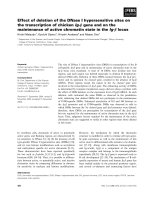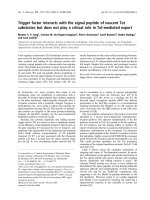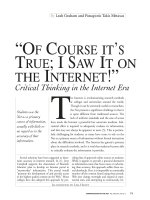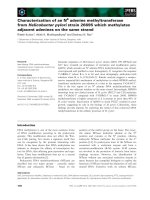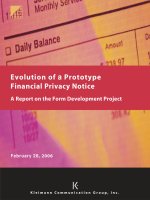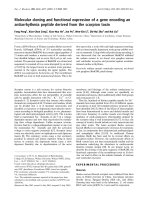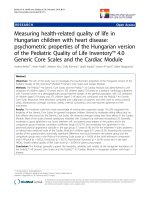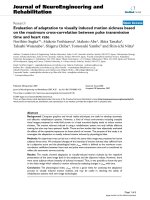“OF COURSE IT’S TRUE; I SAW IT ON THE INTERNET!” Critical Thinking in the Internet Era pptx
Bạn đang xem bản rút gọn của tài liệu. Xem và tải ngay bản đầy đủ của tài liệu tại đây (96.88 KB, 5 trang )
T
he Internet is revolutionizing research methods
at colleges and universities around the world.
Though it can be extremely useful to researchers,
the Net presents a significant challenge in that it
is quite different from traditional sources. The
lack of uniform standards and the ease of access
have made the Internet a powerful but uncertain medium. Sub-
stantial effort is required to adequately evaluate its information,
and this may not always be apparent to users [5]. This is particu-
larly challenging for students, as many have come to rely on the
Net as a primary source of information without formal instruction
about the difficulties involved. The Internet has gained a primary
place in research methods, and it is vital that students become able
to critically evaluate the information it provides.
By Leah Graham and Panagiotis Takis Metaxas
COMMUNICATIONS OF THE ACM May 2003/Vol. 46, No. 5 71
Several solutions have been suggested to deter-
mine accuracy in Internet research. In [1], Jerry
Campbell supports the Association of Research
Libraries’ plan to develop an Internet portal to
“trustworthy” information. This portal would
“promote the development of and provide access
to the highest quality content on the Web.” Many
colleges have also adopted this approach by pro-
viding lists of approved online sources to students.
While it appears to provide a practical alternative
to information.coms that focus more on advertis-
ing than accuracy, this approach suffers from sev-
eral drawbacks. First, it is impossible to continually
monitor all the content found using these portals.
Web sites change overnight and expand at expo-
nential rates, and attempting to continuously ver-
I
LLUSTRATION BY LISA HANEY
Students use the
Net as a primary
source of information,
usually with little or
no regard as to the
accuracy of that
information.
“OF
COURSE IT’S
TRUE; I SAW ITON
THE
INTERNET!”
Critical Thinking in the Internet Era
72 May 2003/Vol. 46, No. 5 COMMUNICATIONS OF THE ACM
ify every page of each linked site would be an incredibly
time-consuming task. Clearly, this is not feasible, but it
would be necessary to ensure the accuracy and timeli-
ness expected of information found using a “scholar’s
portal.” Additionally, this approach places the responsi-
bility of evaluation on the Web masters of these portals.
A more interactive approach that encourages users to
develop critical-thinking skills would provide lasting
value, while preventing them from becoming depen-
dent on these portals for the correct answers.
Developing other approaches requires a firm under-
standing of how students currently use the Internet for
research. Consider the results of an informal question-
naire distributed by Angela Weiler in 1999 at SUNY
College of Agriculture and Technology, Morrisville,
NY. In response to a question asking how students
would ascertain if online sources
were accurate enough to be consid-
ered “a good source of information,”
29% said they accepted Internet
information regardless, with only
34% considering additional verifica-
tion important [5]. These startling
results confirm the importance of
further study to provide specific
information about students’ online
research practices. To address this, we developed a six-
question survey administered to 180 Wellesley College
students during the 2000–2001 academic year. Stu-
dents’ responses to this survey helped explain how col-
lege students, from different backgrounds, class years,
and majors, react to information on the Internet.
Research Methods
Participants in this study were students from the
“Computers and the Internet” class; it was, in fact, their
first assignment. Students were told the purpose of the
survey was to understand how students conduct
searches. The survey was divided into seven email mes-
sages. The first explained the process of responding to
the survey and included a personal information ques-
tionnaire. The following six email messages each con-
tained one question and asked students to report their
answer and search strategies.
The survey was designed to answer three research
questions:
• How strongly do students rely on the Internet for
information?
• What claims are students more likely to believe?
• Who is most susceptible to misleading claims?
To identify students’ reliance on the Internet, they
were told to answer the questions in whatever way
they wished. They were free to use any resource avail-
able, including visiting the library, and they were asked
to report which search methods were used for each
question.
The six survey questions were used to determine stu-
dents’ ability to evaluate information, as well as their
inclination to verify their responses. Four questions
tested particular areas of misinformation: advertising
claims, government misinformation, lobby group pro-
paganda, and scams. Preliminary research indicated
these areas could present a significant challenge to stu-
dents. Two additional questions were used to deter-
mine if students were more diligent about accuracy and
verification when the information was easy to find.
Each response was given a score from 0–3, with 3
being the highest score. The scoring system placed
equal weight on accuracy and the
students’ efforts to double-check
responses (see Table 1). An opti-
mal answer was therefore defined
as a correct response confirmed in
at least two sources. Other scores
were categorized as follows:
A 0 indicates no response, a 1
an incorrect response that was
not double-checked, and a 2
either a correct answer that was not double-checked or
an incorrect response that was double-checked. The 2
category contains both types of responses, as dividing
the category would require placing more importance
on accuracy or verification. Neither of these attributes,
when considered individually, wholly constitutes ade-
quate research practices. As such, the 2 category
remains the middle category for responses not entirely
acceptable due to a lack of accuracy or verification.
Finally, to evaluate which groups of students are in
greater need of assistance, students were asked to fill
out a questionnaire asking for age, class year, and other
factors. This data was matched with their responses to
the survey questions.
Results
The findings were remarkable. Regarding students’
reliance on the Internet, it became apparent that stu-
dents are very eager to use the Internet—and only the
Internet—in conducting research. Though the survey
was not in any way limited to Internet resources, less
than 2% of students’ responses to all questions
included non-Internet sources. Many of these
responses also quoted online sources at some point.
This finding emphasizes the importance of teaching
good Internet research skills, as students rely so heavily
on the Internet.
The survey also revealed the extraordinary confi-
Score Correct Double-Checked
0
1
2
3
-
No
Ye s
Ye s
-
No
Ye s
Ye s
-
-or-
Table 1. The survey scoring system.
COMMUNICATIONS OF THE ACM May 2003/Vol. 46, No. 5 73
dence students have in search engines. If the survey
question did not mention a particular Web site, almost
all students immediately turned to a search engine.
Many remained faithful to one search engine through-
out the survey, even if it did not immediately provide
the answer sought. This is particularly interesting since
experts believe no single search engine captures more
than 16% of the entire Internet. With all search engines
combined, this only increases to 42% [2]. Additionally,
students were asked a question to determine the extent
of their understanding of search engines. Few students
responded with any degree of awareness of the process
by which search engines post results. This is distressing,
as the reliability of search engines to faithfully and self-
lessly guide users to appropriate materials has often
been questioned.
1
The second research question about the types of
information most problematic to students yielded dis-
heartening results. Students were overwhelmingly sus-
ceptible to three types of misinformation—advertising
claims, government misinformation, and propa-
ganda—and somewhat susceptible to scam sites.
The two most successful misleading claims were
advertising and government misinformation. To study
the impact of advertising claims, students were asked:
“List three major innovations developed by Microsoft
over the past 10 years.” The term “major innovation”
was left vague, as Microsoft’s innovative history is a
widely debated issue. There are many opinions on the
topic, and we expected students overall to discuss at
least several.
However, 63% of students responded that Microsoft
was responsible for many major innovations based on
information from only one source. Almost all of these
students immediately went to the Microsoft Web site
and used the Microsoft Museum Timeline that details
Microsoft’s achievements—or at least, what Microsoft
claims to be its achievements. Only 12% checked sev-
eral sources and made more complete argument. Some
22% fell in between these two groups, receiving a score
of 2. These results are intriguing in view of recent liti-
gation against Microsoft that drew worldwide attention
to its business practices and innovation efforts. Yet
almost two-thirds of students responded without a
shadow of a doubt that Microsoft was completely hon-
est about its claims.
Government misinformation followed closely
behind advertising claims. Students were asked: “Did
the 1999 Rambouillet Accords allow NATO to operate
in all of Yugoslavia or only in Kosovo?” The correct
answer—all of Yugoslavia—can be found in the actual
document, though it is difficult to wade through its
82 pages. The complete text can be found online, but
summaries and reviews are much more common. A fre-
quently found summary is the U.S. Department of
State Bureau of European Affairs fact sheet released on
March 1, 1999, which implies that NATO presence is
limited to Kosovo.
2
A total of 62% of students said that NATO is lim-
ited to acting within Kosovo based on one source, and
many listed the State Department memo as their only
source. And 26% said the same thing but made some
effort to double-check the information or happened to
find the correct answer on the first attempt. Many stu-
dents in this category stumbled on anti-NATO Web
sites and reported that information without checking
another less-biased source. Only 10% found the correct
answer and verified it in two places.
Political lobbying groups are another common
source of misinformation or half-truths. Students were
asked to evaluate a claim made by getoutraged.com.
This Web site is the work of an anti-smoking lobby,
though it is officially copyrighted by the Massachusetts
Department of Public Health. Students were asked:
“Getoutraged.com says that tobacco is responsible for
30% of all deaths in the 35–69 age group. Would you
cite this information in a research paper?” This statistic,
taken from a pamphlet entitled “Growing Up Tobacco
Free,” is actually a projection made in 1992 on how
many deaths tobacco will probably cause in the 1990s,
The survey revealed
the extraordinary confidence
students have in search engines.
If the question did not mention a
Web site, almost all students
immediately turned to a search
engine. Many remained
faithful to one search engine
throughout the survey, even
if it did not immediately
provide the answer sought.
1
See, for example, [2]; “Information Retrieval on the World Wide Web” (Gudivada et
al., IEEE Internet Computing 1, 5 (1997), and “Searching the World Wide Web”
(Knoblock, IEEE Expert 12, 1 (1997).
2
“Understanding the “Rambouillet Accords.” Fact sheet released by the Bureau of
European Affairs, U.S. Department of State, Washington, D.C.;
www.state.gov/www/regions/eur/fs_990301_rambouillet.html
but getoutraged.com lists this as if it were a proven fact
[3]. The number of deaths was actually estimated to be
closer to 20% by organizations such as the American
Cancer Society and the U.S. Center for Disease Con-
trol and Prevention.
3
Despite this, 48% of students said they not only
believed the statistic from getoutraged.com, but they
would confidently cite it in a research paper. They did
not attempt to find a cor-
roborating source. Only
21% expressed reluctance
to use this information
after checking with addi-
tional sources, with 30%
falling in between. What is
most disturbing is that
many of the students who
readily believed this statistic
realized the site was proba-
bly the product of an anti-
smoking lobby, but the fact
it was sponsored by the
Massachusetts Department
of Public Health reassured
them. Students seemed to
believe that because a
source was cited and the
Massachusetts government
copyrighted the Web site,
the statistic would naturally
be accurate.
Fortunately, the results
are not entirely dim. Stu-
dents were much less susceptible to the scam Web site.
They were asked to evaluate vespro.com’s “revolutionary”
product Vespro GHS containing Human Growth Hor-
mone (hGH), an emerging medical treatment to com-
bat the effects of aging. According to the Web site, this
product will decrease body fat, reduce wrinkles, restore
lost hair, and normalize blood pressure, among a variety
of other benefits—an absolute miracle drug. This Web
site provides quotes from medical journals that are gen-
erally taken out of context to support its claims. For
instance, there is a quote from a 1989 article in the New
England Journal of Medicine that seems to support the
beneficial effects of hGH, though its conclusion simply
states further research is necessary [4].
Students were asked: “Would you recommend
Vespro Life Science’s hGH product to a friend con-
cerned about getting older?” Only 13% of the students
immediately agreed to recommend this product with-
out consulting another source while 35% conducted
further research and reported they would not recom-
mend the product without more information. And
52% of students received a score of 2. Though these
results are not overly encouraging, they demonstrate
that students remain skeptical of this type of informa-
tion on the Internet.
The remaining two
questions were used to
determine students’ incli-
nation to verify informa-
tion. The first question
asked students to report
the creator of Linux. The
answer is easily found
quickly online. The sec-
ond question asked stu-
dents to find the land
area of Lisbon, Portugal.
While this sounds ele-
mentary, it can take a
tremendous amount of
time to locate any answer
on the Internet, and even
longer to find a second
source. For the easy
Linux question, 78% of
students reported the first
answer they found, with-
out verifying it from
another source. For the
more difficult Lisbon
question, 75% of stu-
dents reported the first
answer they found with-
out double-checking. It appears that students are just as
likely to avoid verifying an answer, regardless of the
time or effort needed to do so.
Finally, to determine which groups of students are
more susceptible to misleading claims, responses to the
personal information questionnaire were matched with
answers to the six survey questions. Using class year, we
hoped to see if students became better Internet
researchers over the course of their years at Wellesley.
The results indicate there was no significant difference
in performance based on class year (see Table 2).
We then looked at self-reported confidence in their
Internet searching abilities to determine if students
who were more “Internet-savvy” were better able to
critically evaluate information on the Internet. The cat-
egories available were very confident, fairly confident,
slightly confident, and not very confident. Table 3
indicates the total number of scores (0–3) given to stu-
dents in each confidence level. The distribution of
74 May 2003/Vol. 46, No. 5 COMMUNICATIONS OF THE ACM
18
Class Year
Median Total Score
16
14
12
10
8
6
4
2
0
1234D
10.5
10 10 10
10.5
45%
50%
40%
35%
30%
25%
20%
15%
10%
5%
0%
123 0
Ver y
Fairly
Slightly
Not Very
Table 3. Scores by confidence
level.
Table 2. Median score by
class year.
3
“Cigarette Smoking Related Mortality.” Centers for Disease Control and Prevention.
U.S., 1990. Morbidity and Mortality Weekly Report 42, 33 (1993);
www.cdc.gov/tobacco/research_data/health_consequences/mortali.htm
scores for all questions is very similar for each confi-
dence level. Only the “not very confident” group shows
notable, though not overly large, differences. This sug-
gests the confidence a student has in his or her ability
to effectively search the Internet does not significantly
affect the student’s performance.
Conclusion
Clearly, students consider the Internet a primary source
of information. The results presented here suggest
many students have difficulty recognizing trustworthy
sources, though perhaps the underlying problem is a
lack of understanding of the Internet as an unmoni-
tored source of information. All future educational ven-
tures must focus on teaching users the Internet is an
unmonitored method of sharing information. Specifi-
cally, this instruction should equip users to use search
engines effectively, and this requires an awareness of
their technological and financial constraints. This is not
to recommend teaching students that all search engines
are devoid of useful information, but rather to promote
a better understanding of the actual service provided by
search engines.
Students are also not consistently able to differenti-
ate between advertising and fact. Many responses to
vespro.com mentioned that as the Web site was just try-
ing to sell a product, its claims could not be readily
believed. However, many of these same students imme-
diately believed claims made by Microsoft on its com-
mercial Web site. Students must understand that all
information on the Internet is there for a reason, and it
is vital to determine the purpose of the information
when evaluating its accuracy.
The very small number of students who double-
checked information is also concerning. It is commonly
believed the triangle method—locating three indepen-
dent sources that point to the same answer—produces
the most accurate information. This approach does not
differentiate a great deal between “good” and “bad”
sites, but rather encourages users to double-check infor-
mation regardless of the source. Students in this study
seemed to have a great deal of confidence in their abil-
ities to distinguish the good sites from the bad. Colleges
themselves often encourage this attitude as they deter-
mine “good” or “trustworthy” Web sites to help stu-
dents begin Internet research. While it is certainly
useful to provide guidance, it is equally important to
promote the development of critical thinking skills that
will allow students to make use of the entire Internet,
rather than a few approved sites.
Our findings also suggest that students across the
board have similar difficulties in carefully evaluating
information found on the Internet. Older students
with stronger traditional research skills performed no
better than other students, which suggests these skills
are simply not sufficient when evaluating online infor-
mation. In the past, the greatest problem facing
researchers was finding information; now, with the
advent of the Internet, the greatest problem is evaluat-
ing the vast wealth of information available. Students in
this survey placed greater emphasis on the process of
finding an answer than on analyzing the actual infor-
mation. The difficulties students encountered suggest
this practice is of little use in determining the accuracy
of online information. It is therefore important to
develop specific research practices for Internet searches
that take the structure and purpose of the Internet into
account.
As students continue to view the Internet as a pri-
mary source of information, without a significant shift
in training methods, this problem will only worsen. It
is vital that students better understand the nature of the
Internet and develop an instinctive inclination for veri-
fying all information. This will allow students to take
advantage of the tremendous benefits provided online
without falling prey to the pitfalls of online research.
References
1. Campbell, J. The case for creating a scholar’s portal to the Web: A White
Paper. Libraries and the Academy 1, 1 (2001).
2. Introna, L. and Nissenbaum, H. Defining the Web: The politics of search
engines. IEEE Computer 33, 1 (2000), 54–62.
3. Lynch, B.S. and Bonnie, R.J., Eds. Growing Up Tobacco Free: Preventing
Nicotine Addiction in Children and Youths. National Academy Press, Wash-
ington, D.C., 1994.
4. Salomon, F. et al. The effects of treatment with recombinant human growth
hormone on body composition and metabolism in adults with growth hor-
mone deficiency. New England J. Medicine 32, 1 (Dec. 1989).
5. Weiler, A. Two-year college freshmen and the Internet: Do they really ‘know
all that stuff?’ Libraries and the Academy 1, 2 (2001).
Leah Graham
is a graduate of Wellesley College, Wellesley, MA.
Panagiotis Takis Metaxas
() is an
associate professor of computer science at Wellesley College.
Permission to make digital or hard copies of all or part of this work for personal or class-
room use is granted without fee provided that copies are not made or distributed for profit
or commercial advantage and that copies bear this notice and the full citation on the first
page. To copy otherwise, to republish, to post on servers or to redistribute to lists, requires
prior specific permission and/or a fee.
© 2003 ACM 0002-0782/03/0500 $5.00
c
COMMUNICATIONS OF THE ACM May 2003/Vol. 46, No. 5 75
All future educational
ventures must focus on
teaching users the Internet is
an unmonitored method of
sharing information.
